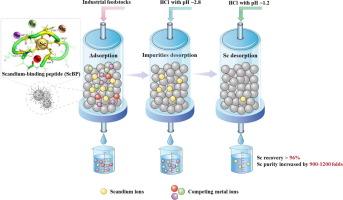Innovative peptide-functionalized microbeads: A highly selective biosorbent for scandium extraction
IF 8.1
1区 工程技术
Q1 ENGINEERING, CHEMICAL
引用次数: 0
Abstract
Scandium recovery from tailings and related leachate offers both economic and environmental benefits, but faces technical challenges due to substantial competing impurities. This study designed a novel metal-binding peptide with high affinity and selectivity towards scandium (ScBP). A comprehensive characterization revealed that oxygen atoms from aspartic acid, glutamic acid and tyrosine residue coordinated with scandium. To facilitate efficient scandium recovery from solutions, the water-soluble ScBP was immobilized on magnetic beads through thiol-maleimide click chemistry. The resulting Mag@ScBP microbeads exhibited a maximum scandium adsorption capacity of 124.92 mg/g and high selectivity for scandium at lower pH. Notably, the microbeads were tested with two types of simulated industrial wastewater generated during the processing of the Bayan Obo mine, achieving over 96 % scandium recovery efficiency for both solutions. Moreover, the purity of the recovered scandium increased by 900 to 1200-fold following a straightforward adsorption–desorption process, highlighting their excellent potential for scandium recovery in complex industrial contexts.

求助全文
约1分钟内获得全文
求助全文
来源期刊

Separation and Purification Technology
工程技术-工程:化工
CiteScore
14.00
自引率
12.80%
发文量
2347
审稿时长
43 days
期刊介绍:
Separation and Purification Technology is a premier journal committed to sharing innovative methods for separation and purification in chemical and environmental engineering, encompassing both homogeneous solutions and heterogeneous mixtures. Our scope includes the separation and/or purification of liquids, vapors, and gases, as well as carbon capture and separation techniques. However, it's important to note that methods solely intended for analytical purposes are not within the scope of the journal. Additionally, disciplines such as soil science, polymer science, and metallurgy fall outside the purview of Separation and Purification Technology. Join us in advancing the field of separation and purification methods for sustainable solutions in chemical and environmental engineering.
 求助内容:
求助内容: 应助结果提醒方式:
应助结果提醒方式:


